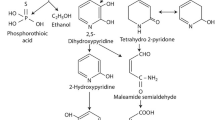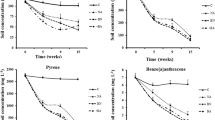Abstract
This study aimed to investigate the biodegrading potential of Arthrobacter sp. MCO, Arthrobacter sp. CSP, and Nocardioides sp. ATD6 in melamine-contaminated upland soil (melamine: approx. 10.5 mg/kg dry weight) after 30 days of incubation. The soil sample used in this study had undergone annual treatment of lime nitrogen, which included melamine; it was aged for more than 10 years in field. When R2A broth was used as the pre-culture medium, Arthrobacter sp. MCO could degrade 55 % of melamine after 30 days of incubation, but the other strains could hardly degrade melamine (approximately 25 %). The addition of trimethylglycine (betaine) in soil as an activation material enhanced the degradation rate of melamine by each strain; more than 50 % of melamine was degraded by all strains after 30 days of incubation. In particular, strain MCO could degrade 72 % of melamine. When the strains were pre-cultured in R2A broth containing melamine, the degradation rate of melamine in soil increased remarkably. The highest (72 %) melamine degradation rate was noted when strain MCO was used with betaine addition.





Similar content being viewed by others
References
Anderson WC, Turnipseed SB, Karbiwnyk CM, Clark SB, Madson MR, Gieseker CMR, Miller A, Rummel NG, Reimschuessel R (2008) Determination and confirmation of melamine residues in catfish, trout, tilapia, salmon, and shrimp by liquid chromatography with tandem mass spectrometry. J Agric Food Chem 56(12):4340–4347
Brown CA, Jeong KS, Poppenga RH, Puschner B, Miller DM, Ellis AE, Kang KI, Sum S, Cistola AM, Brown SA (2007) Outbreaks of renal failure associated with melamine and cyanuric acid in dogs and cats in 2004 and 2007. J Vet Diagn Invest 19(5):525–531
De Paolis MR, Lippi D, Guerriero E, Polcaro CM, Donati E (2013) Biodegradation of α-, β-, and γ-hexachlorocyclohexane by Arthrobacter fluorescens and Arthrobacter giacomelloi. Appl Biochem Biotechnol 170(3):514–524
Dodge GA, Wackett PL, Sadowsky JM (2012) Plasmid localization and organization of melamine degradation genes in Rhodococcus sp. strain Mel. Appl Environ Microbiol 78(5):1397–1403
El-Sayed WS, El-Baz AF, Othman AM (2006) Biodegradation of melamine formaldehyde by Micrococcus sp. strain MF-1 isolated from aminoplastic wastewater effluent. Int Biodeterior Biodegrad 57(2):75–81
Guo Q, Wan R, Xie S (2014) Simazine degradation in bioaugmented soil: urea impact and response of ammonia-oxidizing bacteria and other soil bacterial communities. Environ Sci Pollut Res Int 21(1):337–343
Hatakeyama T, Takagi K, Yamazaki K, Sakakibara F, Ito K, Takas E, Naokawa T, Fujii K (2015) Mineralization of melamine and cyanuric acid as sole nitrogen source by newly isolated Arthrobacter spp. using a soil-charcoal perfusion method. World J Microbiol Biotechnol 31(5):785–793
Jain RK, Dreisbach JH, Spain JC (1994) Biodegradation of p-nitrophenol via 1,2,4-benzenetriol by an Arthrobacter sp. Appl Environ Microbiol 60(8):3030–3032
Jurina T, Terzić S, Ahel M, Stipičević S, Kontrec D, Kurtanjek Z, Udiković-Kolić N (2014) Catabolism of terbuthylazine by mixed bacterial culture originating from s-triazine-contaminated soil. Appl Microbiol Biotechnol 98(16):7223–7232
Kortstee GJ (1970) The aerobic decomposition of choline by microorganisms. I. The ability of aerobic organisms, particularly coryneform bacteria, to utilize choline as the sole carbon and nitrogen source. Arch Mikrobiol 71(3):235–244
Qin Y, Lv X, Li J, Qi G, Diao Q, Liu G, Xue M, Wang J, Tong J, Zhang L, Zhang K (2010) Assessment of melamine contamination in crop, soil and water in China and risks of melamine accumulation in animal tissues and products. Environ Int 36(5):446–452
Shelton DR, Karns JS, Mccarty GW, Durham DR (1997) Metabolism of melamine by Klebsiella terragena. Appl Environ Microbiol 63(7):2832–2835
Shiomi N, Ako M (2012) Biodegradation of melamine and cyanuric acid by a newly-isolated microbacterium strain. Adv Microbiol 2(3):303–309
Strong LC, Rosendahl C, Johnson G, Sadowsky MJ, Wackett LP (2002) Arthrobacter aurescens TC1 metabolizes diverse s-triazine ring compounds. Appl Environ Microbiol 68(12):5973–5980
Takagi K, Fujii K, Yamazaki K, Harada N, Iwasaki A (2012) Biodegradation of melamine and its hydroxy derivatives by a bacterial consortium containing a novel Nocardioides species. Appl Microbiol Biotechnol 94(6):1647–1656
Takagi K, Iwasaki A, Kamei I, Satsum K, Yoshioka Y, Harada N (2009) Aerobic mineralization of hexachlorobenzene by newly isolated pentachloronitrobenzene-degrading Nocardioides sp. strain PD653. Appl Environ Microbiol 75(13):4452–4458
Takagi K, Yamazaki K, Kawase S (2015) Oral presentation at the 60th annual meeting of The Japanese Society of Soil Science and Plant Nutrition, Tokyo, Japan. 8-1-35
Tittlemier SA, Lau BP, Ménard C, Corrigan C, Sparling M, Gaertner D, Pepper K, Feeley M (2009) Melamine in infant formula sold in Canada: occurrence and risk assessment. J Agric Food Chem 57(12):5340–5344
Updegraff IH, Moore ST, Herbes WF, Roth PB (1979) Amino resins and plastics. In: Kirk-Othmer Encyclopedia of Chemical Technology, vol 7, 3rd edn., pp 440–469
Wan R, Yang Y, Sun W, Wang Z, Xie S (2014) Simazine biodegradation and community structures of ammonia-oxidizing microorganisms in bioaugmented soil: impact of ammonia and nitrate nitrogen sources. Environ Sci Pollut Res Int 21(4):3175–3181
Wang H, Geng C, Li J, Hu A, Yu CP (2013) Characterization of a novel melamine-degrading bacterium isolated from a melamine-manufacturing factory in China. Appl Microbiol Biotechnol 98(7):3287–3293
WHO (2009) Toxicological and health aspects of melamine and cyanuric acid., WHO web, http://whqlibdoc.who.int/publications/2009/9789241597951_eng.pdf. Accessed 27 July 2011
Xie S, Wan R, Wang Z, Wang Q (2013) Atrazine biodegradation by Arthrobacter strain DAT1: effect of glucose supplementation and change of the soil microbial community. Environ Sci Pollut Res Int 20(6):4078–4084
Author information
Authors and Affiliations
Corresponding author
Ethics declarations
This article does not contain any studies with human participants or animals performed by any of the authors.
Conflict of interest
The authors declare that they have no competing interests.
Funding
This study was funded by Foundation for Promotion of Material Science and Technology of Japan (MST Foundation).
Additional information
Responsible editor: Robert Duran
Rights and permissions
About this article
Cite this article
Hatakeyama, T., Takagi, K. Bacterial biodegradation of melamine-contaminated aged soil: influence of different pre-culture media or addition of activation material. Environ Sci Pollut Res 23, 14997–15002 (2016). https://doi.org/10.1007/s11356-016-6616-2
Received:
Accepted:
Published:
Issue Date:
DOI: https://doi.org/10.1007/s11356-016-6616-2




